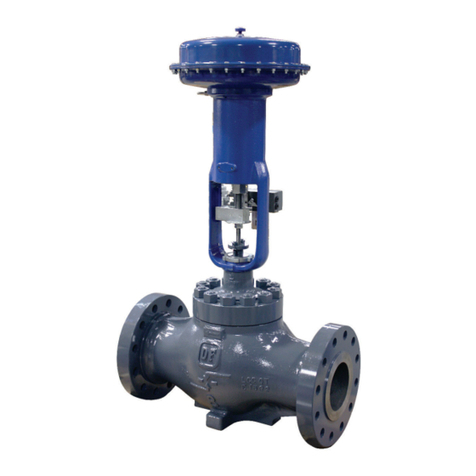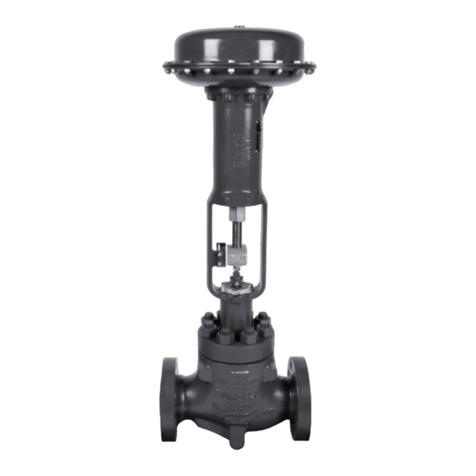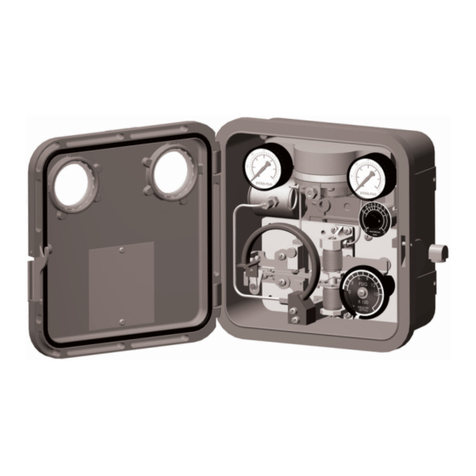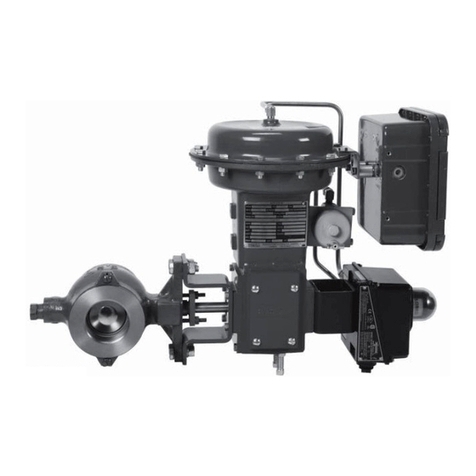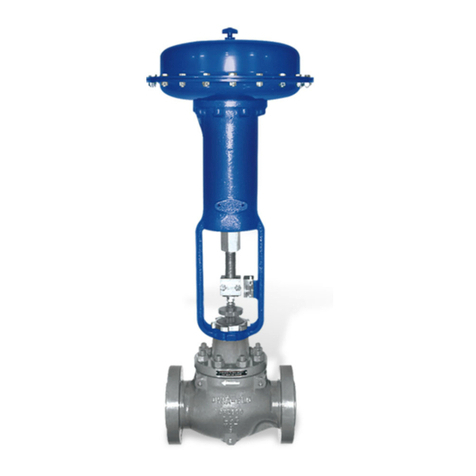
Dyna-Flo Control Valve Services Ltd.
Phone: 780 •469 •4000 Toll Free: 1 •866 •396 •2356 Fax: 780 •469 •4035 Website: www.dynaflo.com
Model 570, 571, 573 Control Valve
P-570M0919A 10
Operation, Parts, and Instruction Manual
INSTALLATION
Before You Begin:
• Read the General and Scope section of this manual (Page 2).
• Read Safety Caution (Page 2).
• The following instructions assume that an actuator is already
mounted to the valve. It is recommended that an actuator
be mounted to the valve and bench set prior to installation,
but not necessary. For Actuator Mounting Instructions refer
to Page 12.
• Place the valve into the OPEN position, this helps to prevent
damage to the valve ball (Key 6) during installation. It is
important that the back edge of the ball never be rotated
past the ball seal, damage to the seal will occur.
• Sudden movement of actuator can cause damage or injury.
It helps to have the actuator de-energized as long as the
valve remains in the OPEN position.
• Use safe work practices and lock out procedures before
placing valve in-line.
Parts Required:
• Flange Studs (Key 44) Note: Flange Studs will very
depending on valve size and model. Refer to Figures 2
and 3, and Tables 4 to 7 for stud size and quantity. The Model
570 is designed to utilize long studs to assist in centering the
valve in-line. Models 571 and 573 use shorter studs to
connect the valve flanges with the line flanges, these studs
do not center the valve in the pipeline.
• Appropriate Line Flange Gaskets.
Lubricants Required:
• Permatex®Nickel Anti-Seize or equivalent (Key A)
WARNING: Keep hands, hair and clothing away from all
moving parts when operating the valve. Serious injury can
result from failure to do so.
1Clean dirt, welding chips, scale, or other foreign material
from the line and flange surfaces.
2Install the valve so the flow through the valve is in the
direction indicated by the arrow on the valve body
(standard flow direction has the seal protector ring (Key 31)
facing upstream). The valve assembly may be installed in
any position unless limited by vibration considerations,
refer to Figures 5 & 6.
WARNING: Excessive wear to the valve may be caused if the
valve is installed with the drive shaft (Key 11) in a vertical
orientation (perpendicular to the ground).
Model 570 Installation
(Refer to Figures 2 and 3, and Tables 4 to 7 for
flange stud (Key 44 I) dimensions)
1Apply Permatex®Nickel Anti-Seize or equivalent
(Key A) to the threads of the two centering flange
studs (Key 44 I). Install the centering studs into the
flanges (refer to Figure 3) before placing the valve
body in-line. The centering studs are used to help
properly center the valve between the pipeline flanges.
2Set the appropriate line gaskets in place between the
valve body and pipeline.
3Set the valve on to the line centering studs from Step
1. Apply Permatex®Nickel Anti-Seize or equivalent
(Key A) to the remaining studs (Key 44 I) and install
them. With the valve properly centered between the
pipeline flanges, tighten the flange stud nuts evenly in
a crisscross pattern to the correct torque
specifications. Proceed to Air Piping (Page 12).
Models 571 & 573 Installation
(Refer to Figures 2 and 3, and Tables 4 to 7 for
flange stud (Key 44 K & L) dimensions)
NOTE: Longer flange studs are needed for the seal
protector ring (Key 31) side of the valve. DO NOT use
standard length studs for the seal protector side of the
valve, refer to Table 5.
1Apply Permatex®Nickel Anti-Seize or equivalent
(Key A) to the threads of the flange studs (Key 44 K &
L) and have them ready to hold the valve in line.
2Set the appropriate line gaskets in place between the
valve body and pipeline.
3Lift and lower the valve in-line, support the valve
during installation. Install the studs (Key 44 K & L).
With the valve properly centered between the pipeline
flanges, tighten the flange stud nuts evenly in a
crisscross pattern to the correct torque specifications.
Proceed to Air Piping (Page 12).

